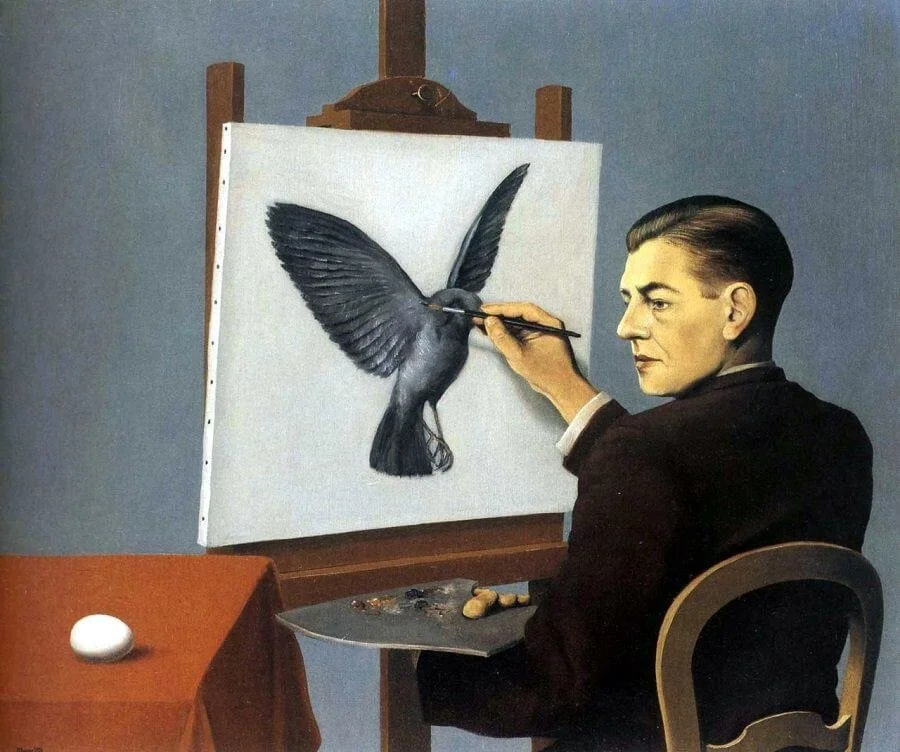Egg, or Crystal Ball
“How do you like your eggs?” the waitress at The Roost asks you one rainy, hungover Sunday morning. The cooks sizzle sausages in the kitchen, the raindrops tap on the window. “Sunny side up,” you answer in your gooey, nebulous post-booze haze.
“Sunny side up”: Every day at The Roost we take the egg’s relation to the sun for granted. That bright yellow sphere which seems to have a glow of its own resting in the egg’s gooey center: “the vitellus or perhaps lux solaris” as McHatten writes in her poem “YOLKSHINE.” Keith-Verfaillie’s image illustrates the same spirit: If it were not for the black lines marking the egg white, the golden sphere at the center of the image would appear to be the sun itself.
If the egg is the space of pure potential, the yolk is the elemental origin–the light from which life springs. The structure of The Mandarin’s new egg zine is itself shaped like the inside of an egg, and so the center of the zine is the yolk–the elemental origin of the whole: a thumbprint inside a tiny book. That oval mark–entirely unique to the individual–contains all potentials.
But what becomes of potential? In my poem “Sitting Inside The Sun” I wrote of the elemental origin: “What emerges then might only emerge almost, is already vanishing.” What does not emerge can never be known, and so is never totally real. Within, the egg is a dream without memory, observation, or goal. “You have to break an egg if you are to know what is inside,” says the man to the girl in Mamoru Oshii’s film Angel’s Egg. This is the terrifying nature of the egg gazed upon from the outside–It is a horrible blankness outside and a horrible blackness within. No light penetrates its shell, so what sits within remains pure mystery.
To meditate upon the image of an egg, to turn it over in your hand and begin to wonder, you start to project images onto the blank canvas of its shell. “The wandering seeker has stepped inside the dream of the egg.” (Light, “Trickster Egg”) Rene Magritte captures this experience beautifully in his painting La Clairvoyance, in which a painter sits gazing upon an egg as if gazing upon a still life arrangement, but on his canvas he has painted the image of a bird in flight–the egg’s future.
Driving past Madame Ruby’s on Mangrove after breakfast, you may well wonder, “what does the psychic know that I don’t?” She may only tell you what you are most afraid of. What sort of curse can she cast upon you, with one glimpse into her crystal ball?
But you have your own tool of divination, sitting lonely in a carton in your fridge. If you look upon an egg with an eye towards the future, that future will emerge. Now that yolk, which was only continuously, harmlessly emerging and vanishing, begins to take form! That monstrous or miraculous form develops muscles, eager to expand…
When an egg begins to hatch, it appears to convulse. What looks like a humble and innocent rocking from the outside, must feel like a shivering, quaking cataclysm within.
Still–an egg is eager to hatch. She who hatches from her shell is born–born of her own violence. A chick hatches from an egg by pecking at her own shell. Perhaps this feels like the destruction of her own world, like a rebellious act of violence, like the end of everything. But those same motions which crack the shell are the very motion which will keep her alive for the rest of her life. It is an essential part of her nature. A bad egg then is the result of a refusal to violently emerge.
Emergence is potentially miraculous and potentially monstrous. How are we to think of it, exactly? Roderick and Sheila in Light’s “Miracle Egg Day” demonstrate one method: They accept the emergent event with wonder, they allow for its possibility. And when it has passed over them they contemplate it genuinely, without jumping to conclusions. Roderick says, “I wanna backtrack [...] Back from ‘miracle’ to just, it happened. That I called it a miracle is part of its happening, yeah, but I want to back off so it can bring other words to mind too.”
Ultimately, to hatch from the shell is only to open up a new world of potentials and possibilities. He who goes inside the mountain crawls out reborn, but perhaps only in more complicated form.
At last, the wisdom of Lewis Carroll’s Humpty Dumpty, the proverbial cracked egg, helps us here. When Alice asks if he can really make words mean so many different things, he tells her, “the question is who is to be master, that is all.” I imagine this was a little advice from Lewis Carroll to himself, for his regular states of reeling and writhing, through his reading and writing process. Humpty Dumpty expresses the power of authority. This is something the man in Angel’s Egg did not understand. He thought he had to smash the egg in order to discover its contents. The cracked egg himself knows that it is up to every individual to decide what potentials and what meanings they want to bring into the world.



